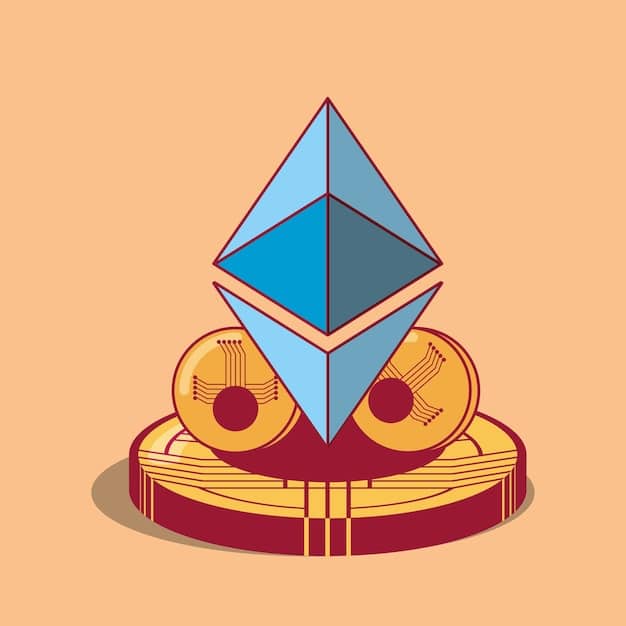Understanding Cryptocurrency Forks: Impact on Investments in 2025

Understanding Cryptocurrency Forks: How They Impact Your Investments in 2025 is crucial for navigating the evolving crypto landscape, as forks can lead to new investment opportunities, alter token values, and affect the overall blockchain ecosystem.
Navigating the world of cryptocurrencies requires a solid understanding of its core mechanisms, and among these, **understanding cryptocurrency forks: how they impact your investments in 2025** stands out as a critical element.
What is a Cryptocurrency Fork?
A cryptocurrency fork is essentially a split in a blockchain network, creating a new version of the cryptocurrency. This occurs when there’s a disagreement among developers and users regarding the rules of the blockchain. Essentially, it’s a divergence, like a branch splitting off from a tree.
Forks can happen for various reasons, most commonly to improve the protocol, fix security vulnerabilities, or introduce new features. Understanding the different types of forks is crucial for any crypto investor.
Hard Forks vs. Soft Forks
There are two main types of forks: hard forks and soft forks. Each has its own implications for the network and its users.
A hard fork is a radical change to the protocol that makes the new blockchain incompatible with the old one. All nodes must upgrade to the new version to continue participating in the network. This results in two separate blockchains and two separate cryptocurrencies.
In contrast, a soft fork is a change that is backward-compatible. Only a majority of nodes need to upgrade, and the new blockchain is still recognizable by older nodes. Think of it like updating an app on your phone – the older version may still work, but the updated version has added benefits.
- Hard Fork: Creates a new, separate cryptocurrency.
- Soft Fork: Backward-compatible update; doesn’t create a new coin.
- Node Upgrades: Hard forks require all nodes to upgrade; soft forks only require a majority.

Differentiating between these two types is vital because hard forks can create entirely new investment opportunities (and risks), while soft forks are generally seen as upgrades to the existing cryptocurrency.
Why Do Cryptocurrency Forks Happen?
Cryptocurrency forks occur when there are disagreements within the community about the future direction, technological improvements, or governance of a blockchain. These disagreements can stem from various factors, leading to the need for a split.
One common reason is to implement new features or improvements that some members of the community believe are necessary. This could include changes to transaction speeds, security protocols, or the introduction of new functionalities.
Common Reasons for Forks
Forks are often the result of differing visions for the future of a cryptocurrency. Let’s break down some key motivators:
- Disagreements: Conflicts in community vision and desired roadmap.
- Technological Improvements: Changes to transaction speed, security or functionality.
- Security Fixes: Addressing vulnerabilities within the existing code.
Another reason is to address security vulnerabilities. If a major flaw is discovered in the code, a fork might be necessary to patch it and prevent potential exploits. This is especially critical given the high value often associated with cryptocurrencies.
Ultimately, forks reflect the decentralized and democratic nature of many cryptocurrencies, allowing communities to evolve and adapt to changing circumstances.
Examples of Notable Cryptocurrency Forks
Several cryptocurrency forks have had a significant impact on the market and the broader blockchain ecosystem. Examining these examples can provide valuable insights into the potential outcomes and implications of forks.
One of the most well-known examples is the Bitcoin Cash (BCH) fork from Bitcoin (BTC) in 2017. This hard fork was driven by disagreements over the block size limit, with Bitcoin Cash increasing the block size to allow for faster transaction processing.
Key Fork Examples
Studying past forks provides perspective on the implications and consequences for investors.
- Bitcoin Cash (BCH): Forked from Bitcoin (BTC) to increase block size.
- Ethereum Classic (ETC): Remained on the original Ethereum blockchain after the DAO hack.
- Bitcoin Gold (BTG): Forked to change the mining algorithm, promoting decentralization.
Another significant fork is Ethereum Classic (ETC), which emerged after the infamous DAO hack on the Ethereum network. Ethereum developers decided to hard fork to revert the hack, while a faction of the community chose to remain on the original, unaltered blockchain, resulting in Ethereum Classic.

These examples highlight how forks can lead to the creation of new, valuable cryptocurrencies, but also how they can reflect deeper philosophical and technical disagreements within the crypto community.
How Forks Impact Cryptocurrency Investments
Cryptocurrency forks can have a profound impact on investments, creating both opportunities and risks for investors. Understanding these potential effects is crucial for making informed decisions.
One of the most immediate impacts is the potential for receiving new tokens from a hard fork. If you hold a cryptocurrency at the time of a hard fork, you may receive an equivalent amount of the new cryptocurrency on the forked chain. This can effectively double your holdings, at least initially.
Potential Investment Impacts
The potential disruption to investment strategy should be carefully considered. These include evaluating:
- Token Value: Forks can cause increased volatility in both chains.
- Investment Decisions: Evaluate the new coin based on merit, not just free distribution.
- Market Sentiment: Community support impacts fork’s longevity and value.
However, this doesn’t necessarily translate into instant profits. The value of both the original and the forked cryptocurrency can be highly volatile in the aftermath of a fork. Market sentiment, adoption rates, and the underlying technology all play a role in determining the long-term value of each coin.
Moreover, forks can introduce uncertainty into the market. Investors may become hesitant, unsure of which chain to support, leading to decreased trading volume and price fluctuations.
Assessing the Value and Potential of a Fork
Evaluating the value and potential of a cryptocurrency fork requires a comprehensive analysis of several factors. This assessment is essential for determining whether to invest in the new cryptocurrency or stick with the original chain.
First and foremost, it’s crucial to understand the reasons behind the fork. What problems is the new cryptocurrency trying to solve? Does it offer genuine improvements over the original chain, or is it simply a matter of differing opinions?
Evaluating a Fork’s Viability
Consider these points when assessing a fork:
- Development Community: Active development and credible leadership are essential.
- Technology: The innovations/solutions to existing problems.
- Market Adoption: The level of usage and acceptance.
The strength and credibility of the development team are also critical. A strong team with a clear roadmap and a proven track record is more likely to succeed in the long run.
Another crucial aspect is the level of community support. A cryptocurrency with a strong and active community is more likely to gain traction and maintain its value over time.
Strategies for Navigating Cryptocurrency Forks in 2025
As cryptocurrency forks continue to be a part of the crypto landscape, having well-defined strategies for navigating them is essential. These strategies can help you protect your investments and potentially profit from new opportunities.
One fundamental strategy is to stay informed. Keep abreast of the latest developments in the cryptocurrency space, including upcoming forks, the reasons behind them, and the potential implications for your investments.
Key Strategies for Investors
Given the complexity surrounding forks, consider these steps:
- Stay Informed: Keep current with developments, community insights.
- Use Cold Storage: For optimal security during contentious periods.
- Diversify: Reduce overall risk exposure in case of unexpected outcomes.
Another crucial strategy is to secure your private keys. If you hold a cryptocurrency that is about to undergo a hard fork, make sure you have control over your private keys so you can claim the new tokens on the forked chain.
Diversification is also a key risk management strategy. Don’t put all your eggs in one basket. Spreading your investments across different cryptocurrencies can help mitigate the impact of any single fork on your overall portfolio.
In conclusion, understanding how forks impact your investments is critical to securing your financial future in cryptocurrency. By following the strategies described in this article, you can effectively manage your risk tolerance. Understanding forks will allow you to participate more confidently in the crypto market.
| Key Point | Brief Description |
|---|---|
| 💡 What is a Fork? | A split in the blockchain that can lead to a new cryptocurrency or an updated version |
| 💰 Investment Impact | Forks can create volatility, double holdings, and introduce new investment opportunities. |
| 📊 Assessing Value | Important, like community, development team, technology. |
| 🛡️ Navigating Forks | Stay informed, protect your private keys, and diversify your investments to manage risk. |
Frequently Asked Questions
▼
A hard fork creates a new, separate cryptocurrency, while a soft fork is a backward-compatible update that doesn’t create a new coin. Hard forks require all nodes to upgrade.
▼
If you hold a cryptocurrency at the time of a hard fork, you may receive an equivalent amount of the new cryptocurrency on the forked chain, effectively doubling your holdings.
▼
Forks cause market volatility, impacting the value of both the original and forked cryptocurrencies. Forks can also introduce overall uncertainty into the crypto market.
▼
Evaluate the reasons behind the fork, the strength of the development team, community support, and improvements offered over the original chain to assess its prospects.
▼
Stay informed about upcoming forks, secure your private keys to claim new tokens, and diversify your cryptocurrency investments to mitigate risk.
Conclusion
By staying informed, securing your assets, and employing strategic diversification, you can navigate the complexities of cryptocurrency forks. This proactive approach allows you to protect your investments while capitalizing on opportunities in the evolving crypto landscape, making you a more resilient investor.





